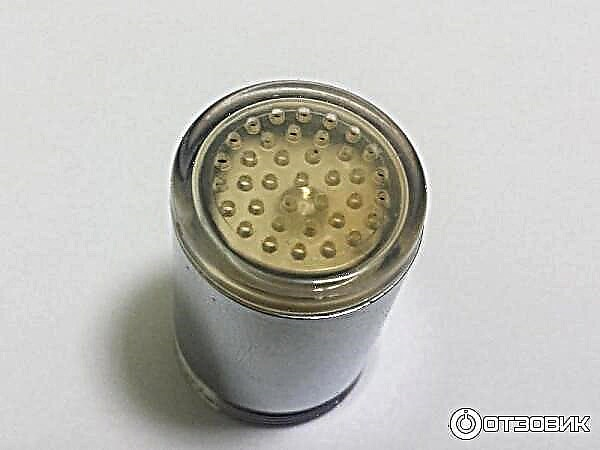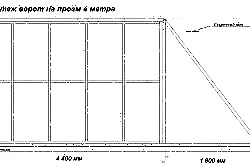Along with modern methods of decorating the ceiling in the house, painting remains one of the most common methods of decorating the ceiling surface. This is a fairly economical type of finishing work, but it requires a responsible approach to all stages. The ideal painted ceiling will have a flat surface, without stains and stains. When performing repairs, it is important to know which types of tools to use best, which paint to choose, how to properly prepare the surface for painting.
Modern methods of painting ceilings
The modern method of painting involves the use of water-based paint, which has a number of positive characteristics.

Types of water-based paint:
- Acrylic The most popular decorative paint, characterized by high quality and affordable price. Applying just two coats of paint will provide the perfect finish. Acrylic is sensitive to moisture and fumes.
- Silicone Quality paint at a high price. It has the best characteristics: it is resistant to vaporization, dirt-repellent, elastic. The paint is ideally laid on the surface, able to mask large cracks.
- Silicate. This high quality paint. I mainly use it for painting industrial premises. It is also suitable for decorating the kitchen and bathroom. Paint prevents mold and mildew. The material is resistant to steam. She can successfully fill the leak.
Each of the species is presented in a wide color palette, which allows you to come up with an original design and decoration for the ceiling. For this, stencils, non-woven fabric can be used if pieces of wallpaper remain after repair. Using these materials, an original ceiling decoration can be made to complement the overall style of the interior. Design options can be varied.
An important aspect when choosing a paint is the study of indicators on the package. To determine the paint consumption, you need to pay attention not to the amount in the bank, but to the indicator of paint consumption per square meter.
After choosing the paint, its composition, having decided on the area of painting, you need to pay attention to the choice of tool. The smooth surface of the painted ceiling depends on this.
Application tool
- Roller
- Brush,
- Electric spray gun.
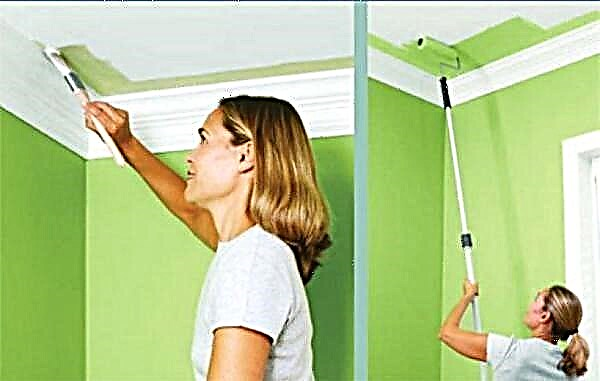
Painting ceilings depends on the choice of method of applying paint and its quality. An important aspect is the qualification of the master performing the finishing work.
How to paint the ceiling: perfect surface technology
Painting the ceiling consists of several stages of work. The first stage is very important, the next stage and even the entire success of the finishing work depends on it.

Phased preparation of the ceiling:
- Surface alignment. The process will be the same for any ceiling, whether it is concrete or from fiberboard. It is necessary to clean the old finish. If defects are found, putty and plaster methods must be used. If the defect is very large, foam is used to eliminate it.
- Maximum alignment. Depending on the state of the ceiling plane, putty is applied in one or several stages. When applying several layers, it is important to monitor the quality drying of each.
- Putting the last layer of putty. For this, satengips are used. It is applied with sandpaper, which helps to bring the surface to the most even state. The last layer should be dried well, apply a primer and wait for it to dry.
After thoroughly preparing the paint and tool selection surface, you can proceed to the painting phase.
Phased staining:
- The right direction of painting is from the corner to the center, best from the window opening.
- To apply paint smoothly without pressing the tool too hard - this can lead to the formation of smudges.
- Apply strips of paint in parallel without leaving any gaps between them.
In painting, a lot depends on the tool used. With practice, the painting process becomes more successful.
It is important to know that often with a single coat of paint you can hardly do. For the most beautiful effect, experts advise applying several layers. A prerequisite is the drying of each layer before applying the next.
Each layer is best applied with new tools to avoid the risk of mixing paints and other troubles.
Is it possible to paint the ceiling with old paint
Those who hope to tint old paint will be disappointed. Professionals advise to apply paint only on the prepared surface. Otherwise, the old paint, which exfoliates, will not allow the new one to qualitatively cover the surface. Especially white defects will give out defects.

The process of cleaning the ceiling from old paint will be easier if there is no fungus, mold on the old surface, and the plaster remains in good condition.
Preparation of the surface for painting will consist in cleaning it from the old finish.
Cleaning Steps:
- Using a steel spatula, clean the surface, saving it from thick layers of old paint.
- Using a brush, begin to prime the surface.
- Putty irregularities, after allowing the primer layer to dry.
Usually putty dries within 6 hours. After that, it is necessary to treat it with a special grouting grid, after which an additional primer coat should be applied to the ceiling.
Do-it-yourself ceiling paint: professional advice
It is possible to paint the ceiling with enamel with your own hands. Before painting yourself, you need to study the consistent instructions for painting, as well as the advice of a professional for those who decide to finish on their own.

Tips & Tricks:
- You need to paint quickly.
- When painting several levels for each, you must use your own tools.
- Use a plastic barrier that protects the walls from splashing.
- Glue spider web and masking tape come in handy for accurately painting the joints of surfaces.
- Allow the paint to dry evenly in a dark room without drafts.
When painting the ceiling yourself, it is important to pay attention to the putty of the surface.
It is important to know why a poorly prepared surface can spoil everything, and at what stage the painted ceiling can produce a defect after painting. The paint will lie unevenly, spots and pits will appear on it, you can also notice that bubbles appeared on the surface. Correcting the situation will be difficult. To avoid this, you need to take care of creating the most even surface.
Paint should be applied according to the wet edge rule. Paint layers should be applied strictly after the previous coat has completely dried. For a high-quality result, you can paint the ceiling with Snezhka - this is paint that has won the trust of quality and reasonable prices.
How to paint the ceiling (video)
The solution for painting the ceiling of an apartment is an economical and high-quality method of decoration. The quality of design depends on many factors: the quality of the selected paint, its features and characteristics, the type of paint tools and the professionalism of the paint. In painting the ceiling, there are two main stages: surface preparation and application of paint. Each stage requires a responsible approach, strict adherence to the rules of putty, primer and painting. After the quality work, the painted ceiling will look beautiful and stylish, you can apply a decorative pattern to it that will add originality and charm.
Should I apply new paint over old
There is no unequivocal opinion on this subject. If you ask a specialist, he will say that there should be good adhesion between the two materials, which can only be achieved if the surface is previously cleaned of the old coating.
But, in practice, many people carry out such cosmetic repairs and for a long time forget about problems with the ceiling. However, in this case it is necessary to take into account several important aspects:
- It is recommended to apply the composition to the ceiling that will be similar to the one that was used previously.
- If there are already so many layers of paint on the ceiling, serious defects are visible, then in this case it is still worthwhile to dismantle the old coating. If part of it already falls off, then a fresh layer will be able to be contained only for a very short period.
- If calcareous whitewash was previously applied to the ceiling, then in this case there is only one option - remove the old coating and carry out the treatment according to the standard scheme.

It is worth paying attention to the fact that the water emulsion is different. Gone are the days when there was only one type of mixture on sale. Today, there is a paint on sale that is unstable to water and compounds that, on the contrary, cannot be washed off so easily. If the old layer is water-based, and you plan to use the same type of paint, then in this case it is better to remove the old coating. The fact is that while you apply new paint, the old one will begin to get damaged. This will lead to exfoliation.

Types of water emulsion
All paints that belong to this category are aqueous emulsions that consist of particles of pigment and binders. Today on sale you can find many varieties of such compounds:
- Acrylic This is the most popular option, which is used for residential premises. It is easy to guess that the composition of such mixtures contains acrylic resins. This latex emulsion also has latex supplements. All this makes acrylic paint durable and resistant to moisture. Due to its high elasticity, it hides well the irregularities of the old coating and penetrates into cracks with a width of not more than 1 mm.
- Silicone These are waterproof and persistent water dispersion compounds, which are essentially an intermediate form of chemically pure organics and substances of inorganic origin. As a rule, they are used for bathrooms and other rooms with high humidity. Silicone resins allow you to create a reliable coating, but it should be noted that such emulsions are not suitable for the ceiling, if it has major defects. Such paint is used if there are cracks on the surface with a width of not more than 2 mm.
- Silicate. These compounds resemble silicone. Only in this case, the basis is liquid glass. Additionally, silicone-organic resin may be present. However, they are very expensive, and their characteristics are more than enough for a living room, so they are most often used in the industrial sector.

Useful! If we talk about the best manufacturers, then from the most expensive paints of this type it is worth highlighting the products of Tikkurila, Kaporol and Duf. From the middle price segment, preference should be given to Tex paints.
Mineral and polyvinyl acetate paints are also on sale. They are not popular, as they are highly permeable. There are latex formulations, but they are too expensive.
Useful! When choosing a water emulsion, it is better to choose the composition on the marking of which the highest covering ability parameter is indicated. The higher it is, the fewer layers you will need to achieve the best result.
Choosing a paint and making sure that the ceiling is not so damaged, you can start work.
Preparatory work
At this stage, it is recommended to carefully examine the ceiling and assess its condition. Specialists recommend using special lighting "at an angle", this will reveal all the flaws. If there are serious defects on the ceiling, then it is necessary to remove exfoliated elements, put putty on those places where there are deep potholes and treat everything with a primer.

Important! If you find mold on the ceiling, then you must get rid of it and treat this place with special impregnation, which will prevent the spread of spores.
The prepared ceiling dries out pretty quickly. For example, if you applied a primer in the morning, then after lunch you can already start painting. The second coat of water emulsion (if necessary) is usually applied the next day.
Painting
Work on applying a fresh layer of water-based paint on top of the old layer is as follows:
- We prepare the necessary tools. To work, you need a brush 3-4 cm wide, a roller, a tray for paint (cuvette), rags and a telescopic handle. You also need masking tape and polyethylene (or you can buy a special covering material with adhesive strips).
- We cover furniture and floor with polyethylene.
- We study the instructions for the selected paint. Some formulations are sold ready-made, others require dilution with water. In addition, the addition of pigment (tint) may be required if you plan to create a colored ceiling coating. It is also important to adhere to the exact proportions, as they may differ depending on the manufacturer of the coloring composition.
- Pour the right amount of paint into the cuvette. We lower the brush into the composition, blot it so that the paint does not drip and carefully process all the corners and joints. Also, with a brush, decorative elements from plaster, if any, are processed.
- We take the roller and begin processing the ceiling. In the wide part of the cuvette, the roller is wetted, and in the narrow part it gets wet and scrolls several times so that the paint is evenly distributed over it.

- Moving the roller in parallel movements, we begin to apply the composition. It is necessary that each subsequent strip overlap the previous half.
- If you need to add another layer, then you need to do this the next day. Experts recommend applying the topcoat parallel to a window or other light source. To do this, use a new, softer and better roller nozzle. Thanks to this, you can get a smoother finish.
If the old coating is damaged or is a lime whitewash, then it is better to remove it.
Features of dismantling the old coating
If lime whitewash was previously used on the ceiling, then the easiest way to get rid of it is to dampen the ceiling surface well. Lime has excellent absorbency, so it is best to apply water several times. The thicker the whitewash layer, the more moisture will be required.
After that, open the windows in the room. Under a draft condition, the lime starts to bubble and peels off quickly. After that, it can easily be removed with a conventional spatula. You need to work with safety glasses, after which it is recommended to rinse the surface again with water.
If you need to dismantle a layer of old water-based paint, which is badly damaged, then of course you can try to wash it off or get rid of it with a spatula. But, this is a very long and dreary process. Therefore, it is best to use a special chemical composition that will quickly corrode the old paint. However, before using it, you need to carefully study the instructions. Work is carried out in a respirator, goggles and rubber gloves. Additionally, you need to take care of the good ventilation of the room. The water emulsion quickly reacts with chemicals and begins to bubble, after which it is easily and quickly removed by sandpaper and a spatula. At the final stage, it is enough to rinse the surface with water.

If there are large gaps on the ceiling and potholes they need to be putty. After that, irregularities are erased with fine-grained emery paper.
In custody
Indeed, the old ceiling surface can be covered with a fresh layer of water-based paint without long preparatory work. However, it all depends on the type of coloring composition and the condition of the old coating. Of course, an ideal and more durable option would be to completely dismantle the old paint. But, if there is no time and extra money, then you can save.
Process features
Paint the ceiling is not as difficult as it seems at first glance. As a rule, before this process, workers clean off the old finish. The fact is that a thick layer of old paint can shine through and spoil the appearance of the surface. If cracks appear on the ceiling, then the matter is completely hopeless - no matter how you paint over them, they will still be visible. If the repair has not been carried out for a long time, then under a layer of old paint you can even find mold that will nullify all your attempts to update the surface.
If there are no such serious problems, then you can safely apply a new layer of water-based emulsion, acrylic, to the old paint. Carefully inspect your ceiling. If its appearance suits you, and the pieces of paint do not fall off, you can leave everything as it is.
Professionals advise you to pay attention to the following: if you used to paint the ceiling with water-based paint, then you are in luck. She's better than whitewashing. Even if paint of this type begins to peel off and fall off in pieces, it can not be completely removed. You can safely limit yourself to surface cleaning by removing peeling pieces and cleaning the area around them. After this short work, you can safely apply a new coat of paint.
Paint selection
If you decide to paint the ceiling on top of the old layer of material, then you will have to deal with the issue of choosing the right option. For such work, different paints are used. Each type has its own advantages, and a number of disadvantages.

Acrylic
Perhaps this type of paint is most popular. It is good because it is highly resistant to all kinds of contaminants and dries quickly. So you can safely use this material, for example, in the kitchen, where working with food does not always go smoothly.
Such paint also withstands high humidity. If there is any contamination on the painted surface, it can be safely removed with a damp cloth or napkin, without fear that the paint will crack.
Acrylic paint can be easily applied to a variety of surfaces. It fits well on metal, and on wood, and on plastic, and even on already plastered foundations.
Acrylic painting is also good because it perfectly hides minor surface imperfections. Textured paint is able to mask small cracks or places where pieces of the coating have already fallen off.
It is pleasantly pleasing that such a coating dries quickly and retains its color for a long time. Even if you paint the ceiling in a room where the sun will constantly fall on it, the paint will fade and not immediately burn out. However, there is one caveat: when choosing this type of paint, remember that the color of the coating applied to the ceiling will be slightly different from the one you see on the package, because the material immediately darkens. This can not be called such a big drawback, because there are a lot of colors, and you can always find exactly the shade that will ultimately suit you.
With all these positive aspects, it is worth noting that the paint is not so expensive. You can buy a kilogram of paint at a price of about a thousand rubles. Yes, and it will be consumed quite slowly - you will need less packaging material for painting the ceiling in a medium-sized room. About 100 g of paint is consumed per square meter.
Latex
There are several other types of paints that are suitable for the ceiling. One of the most expensive options is latex. This paint is ideal for painting the ceiling on top of the old layer. The fact is that it perfectly conceals defects, microcracks on any surfaces. You can easily wash or wipe the ceiling painted with this material.
Silicate
Cracks (up to two millimeters) can mask and silicate paint. However, it is more expensive than most analogues.
In addition, it is important to remember that silicate paints, as a rule, are not used in residential premises.

This is a coating that is used for profiled wall decoration. and ceilings in industrial premises - for example, in warehouses. At the heart of this paint is liquid glass. This coating is best placed on a concrete or stone surface.
Water emulsion
Water dispersion paint also often painted ceilings. However, it should be used in dry rooms - for example, in living rooms or bedrooms. This type of coating does not tolerate high humidity and quickly becomes covered with cracks, dark spots (in the bathroom or even in the kitchen). The cost of water-dispersion paint is low, which just makes it popular. In addition, it can be matte or glossy, which is convenient for those who design their premises in a certain style and do not want to upset the harmony in the room.
Of these basic types of paint for repainting the ceiling, you can choose any. It can be dense and structural, oily, very light - it all depends on your ceiling, what are your financial capabilities.
Tassels
Brushes of different sizes can be used both for painting the base, and for joints, trim elements. When painting the main part of the ceiling, they are not very effective.
If you decide to paint such a large surface with brushes, then choose the widest ones. Joints with walls, stucco molding and other decorative details are just more convenient to paint over with brushes.


Roller
It is much more convenient to paint the ceiling with a roller. To paint the ceiling use foam tools. The second most popular option is a roller with a fabric base. The length of this ceiling painting tool can vary from five to thirty centimeters.


Airbrush
It is most effective to use a spray gun. However, not everyone prefers this option. The fact is that a spray gun is not only more expensive than all other devices, but also more difficult to use. If you are not a professional, then you will need to adapt to the spray gun first.


How to dilute and calculate the amount?
Having decided on the type of paint and tools, you can proceed to the preparatory work. First you will need to dilute the required amount of material.
Paint consumption depends on how big your room is., the area of the ceiling is very important. As a rule, all the necessary information that will help you calculate the paint is on the packaging. Check out this information.

Having chosen a water-based paint, you will see on the package that it is not worth diluting it. If the product you bought has already thickened, then you can slightly dilute it with water. Otherwise, just mix the paint, roll it on a pallet and start painting.
The preparation of other ceiling paints is not much different. In the acrylic mixture, you will also need to add a little water. It is best to use the product immediately after you stir it. It should not be allowed to freeze.
Subtleties of application
Painting the ceiling without first removing the old paint layer is slightly different from the usual repair work. You will save a little time, because you do not have to completely remove the old layer and putty or primer the ceiling again. It will be enough to work out the zones with cracks and remove the falling off pieces of the paint material. If the paint is peeling off, it will need to be fixed, otherwise the surface of the ceiling will appear to be uneven and sloppy.
When you deal with the most noticeable shortcomings, you will need to move on to the main work. Diluted paint should be poured into the tray - it should not be too much so that the residues are not dried up or thrown away.


Ceiling painting begins with the most inaccessible places. Walk over them with a narrow brush so that there are no gaps. After that, you can paint the entire surface. It is most convenient to work with a roller. So you can quickly paint the ceiling on top of the old layer and paint over cracks, stains.
Painting the ceiling in this way is recommended in several stages. The first layer can be applied not very carefully, but the second one will need to work very well. Getting started with the second layer is only after the first is completely dry.

DIY is not very difficult to paint the ceiling, even if this is your first time doing it. Follow simple recommendations, be careful - and you will succeed.
Design ideas
The ceiling is a very important part of the interior. The way you will perceive the room will largely depend on how you design it.
If you like minimalism or Finnish style, then the ceiling should not be made bright and filled with a variety of patterns. A plain finish is best. Choose a color that you like and work only with it. It is recommended to give preference to light colors, as they help visually make the room taller.
Ceilings decorated with all kinds of drawings look more interesting. It can be abstract patterns created by thin brushes, or full-fledged drawings. However, working on their creation is more difficult.
Painting the ceiling on top of an old coat of paint is not such a difficult job. You can easily and quickly change the appearance of the room with your own hands and create the design of your dreams.
See how to paint the ceiling in the next video.
How to calculate the flow?
Before buying it is necessary not only to determine the type and color of ceiling paint, but also to calculate the required volume, which is due to its consumption. The amount needed depends on the size of the room, which determines the area of the ceiling. Usually, all the necessary information for calculating the coloring composition is on the packaging, therefore, be sure to read the instructions.

In general terms, you can focus on the following calculations. The average consumption of water dispersion paint for ceilings is about 100 - 120 g / m2. Depending on the surface, at least it will be necessary to apply two to three layers for a high-quality uniform appearance. The material consumption is approximately the same, that when using a roller, that - a brush. If we take into account the lack of experience and the inability to rub the paint professionally, then on average the consumption will be 300 g / m2.
In any case, these are approximate figures, the consumption depends on many parameters, therefore it is better to take paint with a margin.

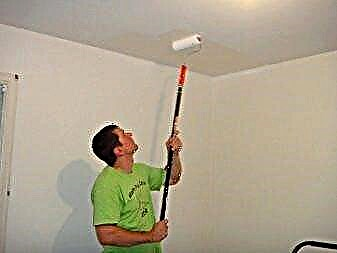
Having chosen the necessary type of water-based paint, on the packaging you can read information about whether it requires dilution. If manufacturers recommend diluting the purchased material, then you can add water to the right amount of paint, as a rule, no more than 5-10% is required. The prepared volume is best used immediately, do not let it thicken again. The best option is considered to be dilution of the paint to the state of liquid cream.
It happens that the material does not require dilution, it is enough only to mix it thoroughly. Such manipulations will suffice if it is planned to paint the ceiling in one layer, in such situations the paint should be a little thicker.


For the entire surface of the ceiling, you should purchase paint from the same manufacturer, of the same brand. This requirement is the guarantee of a uniform monophonic coating.
If it is planned to paint the ceiling not in pure white, then it is better to entrust the tinting to specialists, they will help to choose the right shade and mix the components thoroughly.

How to apply?
It is not difficult to paint the ceiling on the old paint, it can be done by every even inexperienced person with their own hands. After all the stages of preparation, you need to start painting.
The best is considered to be a paint coating consisting of three layers, in this case you can be sure that there will be no stains or streaks on the surface. Before applying each layer, the roller must be carefully rolled out in the tray in order to get rid of the excess amount of the coloring composition, thanks to such manipulations the possibility of smudges is excluded. The first and last layers are correctly applied perpendicular to the windows, this applies to all types of paint, including acrylic.
When painting, sharp movements should not be made, it is necessary to smoothly drive with a brush or roller on the ceiling, slowly, inspecting so that there are no unpainted areas.
The next layer should be applied only on a dried surface, and it is not necessary to speed up the process in any way, the paint should dry naturally.

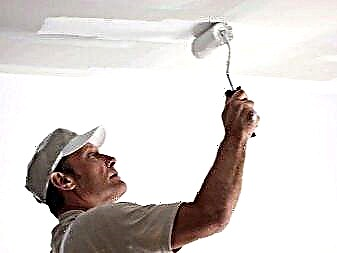
After applying the second layer of paint, it is desirable to exclude the possibility of direct UV rays, as well as the occurrence of drafts, which will help to avoid peeling of the coloring material from the base.
You can paint the ceiling with several types of tools. The most common are a paint brush and a foam roller; you can also apply paint using a spray gun, which is a regular spray gun. This device helps to carry out the painting process much faster, the main thing is that the consistency of the paint is appropriate.
When re-painting the ceiling, it is better to use the same color or close in hue, otherwise you will have to apply a large number of layers to completely paint over the previous coating and achieve the desired result.
Useful Tips
The main step to which special attention should be paid is surface putty. If the ceiling is well plastered, then applying the paint yourself is not difficult. But this process has its own tricks:
- the paint composition should be applied quickly,
- for each layer you need to use separate tools,
- structural paint will help to hide some minor flaws,
- for kitchen, bathrooms it is better to use waterproof washable paint,
- be sure to use plastic barriers that can protect the walls from paint splashes,
- when painting the joints of the surface, glue web and masking tape should be used,
- drying should take place in a dark room in the absence of drafts, otherwise the paint may peel off,
- it is not recommended to perform work in a cold room with high humidity, it also should not be painted in the heat, the coating will dry out too quickly,
- painting should start from the window.
If you follow all the stages of painting and follow the basic rules for applying the paint composition, the process of updating the coating of the ceiling will not take much time, money and will not be difficult, and the result will pleasantly surprise.

